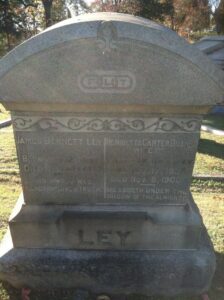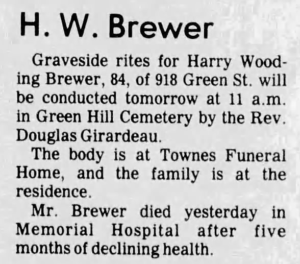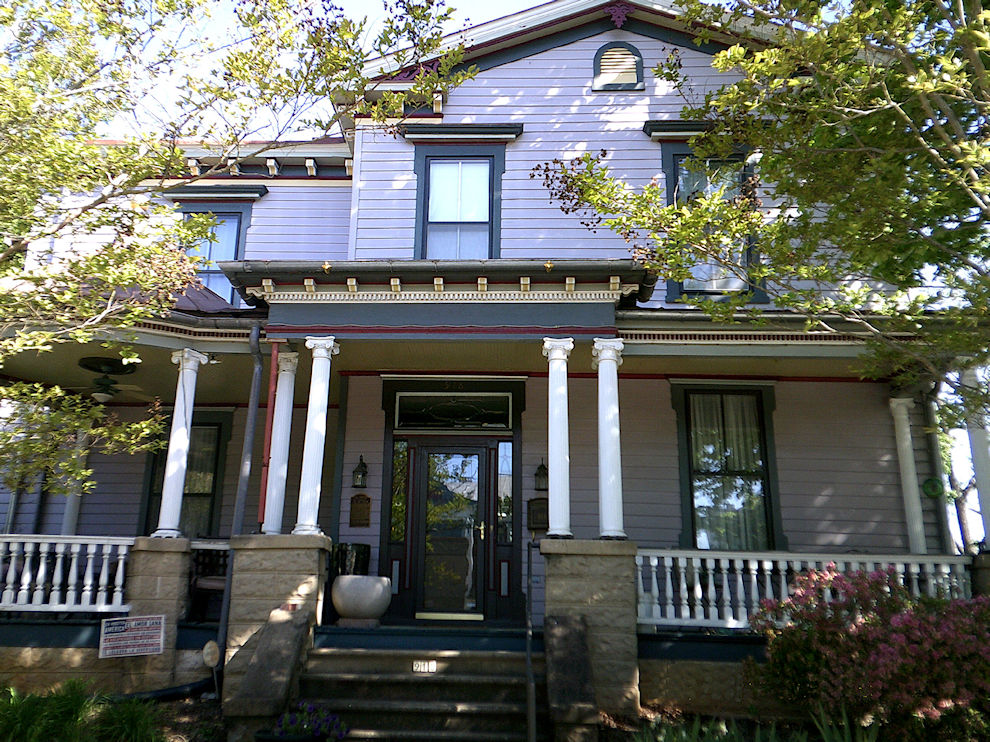 George W. Swain sold the lot of land at 918 Green Street, a portion of his large holdings there, in 1875. The lot was purchased by J.B. Ley. Shortly after, as is illustrated by the Beers’ Map of 1877, a home was constructed there.
George W. Swain sold the lot of land at 918 Green Street, a portion of his large holdings there, in 1875. The lot was purchased by J.B. Ley. Shortly after, as is illustrated by the Beers’ Map of 1877, a home was constructed there.
James Bennett Ley, a native of Richmond, Virginia, was born on the 12th of July 1838. His parents, James Pennett and Elizabeth Reynolds Ley, had arrived from their home of Cornwall, England just a few years prior, and, like his father before him, James was a stone mason. Within a few years of James’ birth, the family had moved from Richmond to establish themselves in Lynchburg.
Mr. Ley served the Confederacy in the Civil War and was Lieutenant in the 38th Battalion of the Virginia Artillery under General Longstreet. Legend has it that it was he who fired the first shot at the battle of Manasses.
In 1861, James married Henrietta Carter Dillard of Lynchburg who was eleven years his senior. James and Henrietta, or “Henny” as she was known, had three children: Nannie Elizabeth, born in 1864, Esmond “Eppa” Forsberg in 1870, and James Mitchell in 1873.
The James family arrived in Danville in 1872, and the Green Street home was likely built shortly after, to be shared by James’ sister Kate and Henny’s sister Nora.
In February of 1889, James and Henny’s daughter, Nanny married Thomas Bass, a tobacconist. In November of that year, Eppa died. James M. married Nora Gitt in February of the following year.
 Henny passed way in November of 1906 and James in March of the following year “after a lingering illness of several months of heart trouble”.
Henny passed way in November of 1906 and James in March of the following year “after a lingering illness of several months of heart trouble”.
After the death of his parents, the home passed to James Mitchell Ley, his wife Nora, and their three children. According to his obituary in the Bee of July 16, 1935 “was for many years cashier of the Old Virginia National Bank, which stood at the corner of Union and Main streets…” Nora died in October of 1914, and, in his grief, and under the shadows of war, he turned his banking acumen toward relief work, organizing drives for the Liberty Loan program, which provided bonds to those willing to loan their private money to the government in exchange for repayment with interest later.
In 1919, James married Mary Emma Moseley. After the First National Bank’s buyout of Old Virginia National Bank, Mr. Ley turned his interests to plumbing and became one of the founders of the Farley Plumbing and Heating Company. When the depression hit, he turned his mind back to banking and during that time developed “theories through which he believed the economic structure could be strengthened.”
On the morning of the 16th of July 1935, Mr. Ley rose from his bed and, upon feeling a pain in his chest, fell to the floor where he soon after died, having succumbed to the same illness as his father. Mr. Ley’s widow remained in the home a few more years, but in February of 1939, she sold the property to James Herbert Brett. Mr. Brett owned the home for only a few years, and it may be he who converted the house into a duplex. By 1940, the house was occupied by F. L. Seaman, a young office manager and his wife, Marie, who lived in one unit, and Vernon Ramey and his wife Mary who occupied the other.
 In 1941, the property sold again. This time to Harry Wooding Brewer. Mr. Brewer was born on the 16th of January 1894 in Danville to James Arthur Brewer and Ida Gould Hibbard, the daughter of a U.S. District Court Judge who moved to North Carolina from New York.
In 1941, the property sold again. This time to Harry Wooding Brewer. Mr. Brewer was born on the 16th of January 1894 in Danville to James Arthur Brewer and Ida Gould Hibbard, the daughter of a U.S. District Court Judge who moved to North Carolina from New York.
Mr. Brewer was secretary and credit manager of Park Place Mercantile Co. for 28 years. He lived in the home for over thirty years before he passed away in 1978.
The property changed hands several times in the twenty years that followed, at last being purchased by Fred Meder in 1997.
Sources:
Census and Vital records found at Familysearch.org
Images and vital information, including biographical sketches found at FindaGrave.com
Death notices and other information found in the Danville Register, Danville Bee and other newspaper archives at Newspapers.com and GenealogyBank.com
Census, Directory, Newspaper, and other information compiled by Paul Liepe
